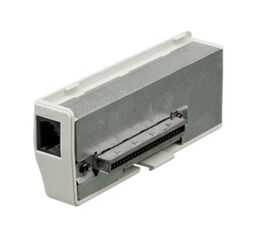Difference between revisions of "Broadband Adapter"
From Sega Retro
Frenchkiss (talk | contribs) m |
|||
| Line 20: | Line 20: | ||
Sega's decision to incoroporate 33.6K or 56K modems into their Dreamcast consoles was based on the theory (later proved true) that most internet users during the late 1990s and early 2000s would be using dial-up connections to get online. However, some had access to faster broadband connections which are incompatible with the standard modem, so the broadband adapter was released to compensate. | Sega's decision to incoroporate 33.6K or 56K modems into their Dreamcast consoles was based on the theory (later proved true) that most internet users during the late 1990s and early 2000s would be using dial-up connections to get online. However, some had access to faster broadband connections which are incompatible with the standard modem, so the broadband adapter was released to compensate. | ||
| − | Two versions of the device were | + | Two versions of the device were released: |
*HIT-300: "Dreamcast LAN Adapter" (ドリームキャスト・LANアダプタ) - this version used a Fujitsu MB86967 chip and supported only 10 Mbit speed, and is only thought to have been released in Japan. | *HIT-300: "Dreamcast LAN Adapter" (ドリームキャスト・LANアダプタ) - this version used a Fujitsu MB86967 chip and supported only 10 Mbit speed, and is only thought to have been released in Japan. | ||
Revision as of 17:10, 18 October 2020

| |||||||||||||||
| Broadband Adapter | |||||||||||||||
|---|---|---|---|---|---|---|---|---|---|---|---|---|---|---|---|
| Made for: Sega Dreamcast | |||||||||||||||
| Manufacturer: Sega | |||||||||||||||
| Type: Network tool | |||||||||||||||
|
This teeny-tiny article needs some work. You can help us by expanding it.
Broadband Adapter (ブロードバンドアダプタ) (commonly abbreviated to BBA) and known as the Dreamcast Link in Brazil, is an accessory released for the Sega Dreamcast. It is a replacement for the built-in Dreamcast Modem, allowing games to benefit from faster internet connections.
Hardware
Sega's decision to incoroporate 33.6K or 56K modems into their Dreamcast consoles was based on the theory (later proved true) that most internet users during the late 1990s and early 2000s would be using dial-up connections to get online. However, some had access to faster broadband connections which are incompatible with the standard modem, so the broadband adapter was released to compensate.
Two versions of the device were released:
- HIT-300: "Dreamcast LAN Adapter" (ドリームキャスト・LANアダプタ) - this version used a Fujitsu MB86967 chip and supported only 10 Mbit speed, and is only thought to have been released in Japan.
- HIT-400: "Broadband Adapter" (ブロードバンドアダプタ) - the more common model. This used a Realtek 8139 chip and supported 10 and 100 Mbit speeds.
No such adapter was released in PAL regions, however the peripherals are not region coded, so an American adapter will function in a PAL system.
The broadband adapter theoretically fulfils the same functions as the standard modem, but is able to perform tasks much quicker, as more bandwidth is available through a broadband connection.
Compatibility
While the Dreamcast Modem is compatible with almost all online Dreamcast games, the Broadband Adapter is only compatible with a subset of the library, owing to the need for developers to explicitly support the device and its late arrival on the market. The games it does support will theoretically run better with a Broadband Adapter than a standard Dreamcast Modem, but if the priority is compatibility, it is not the best option.
Physical scans
References





